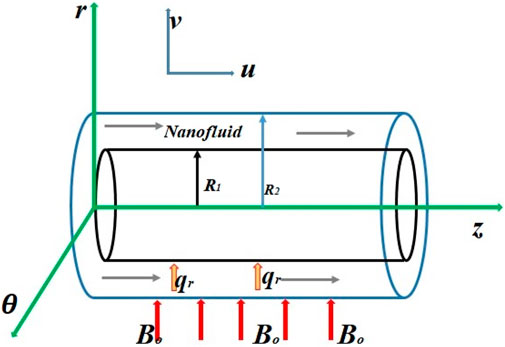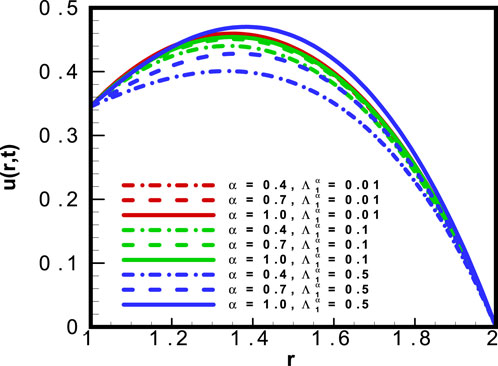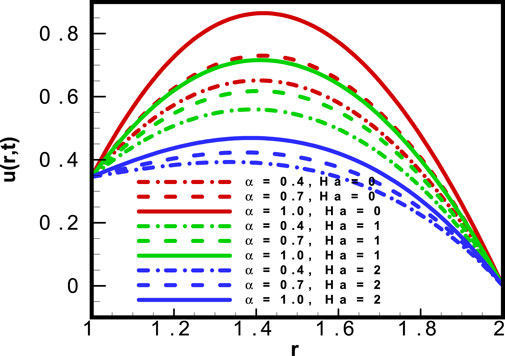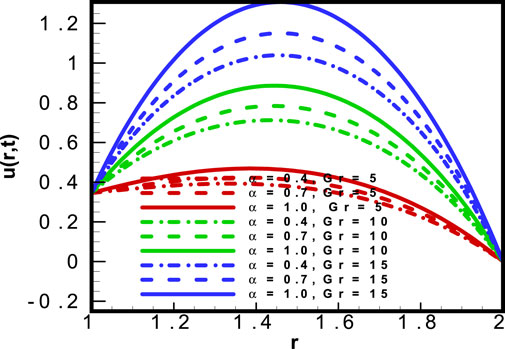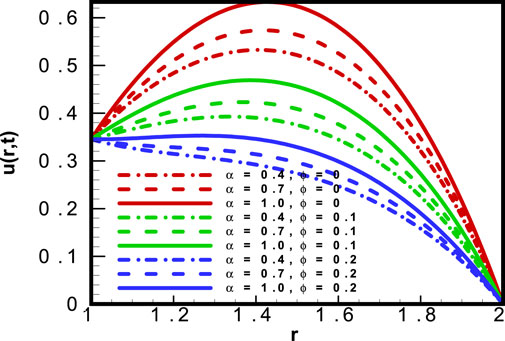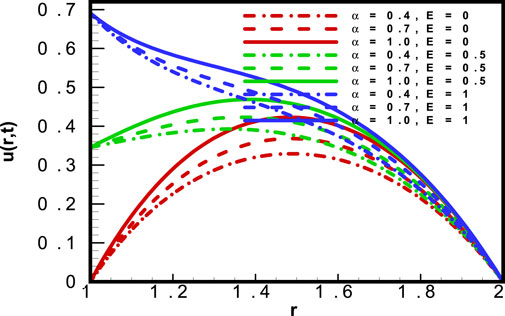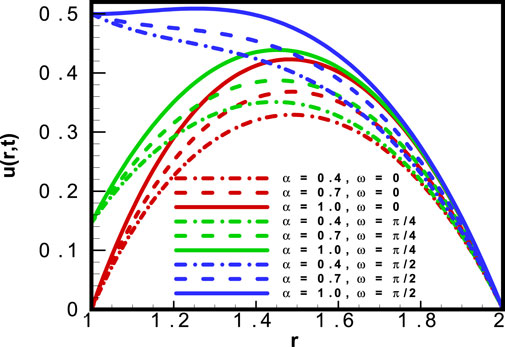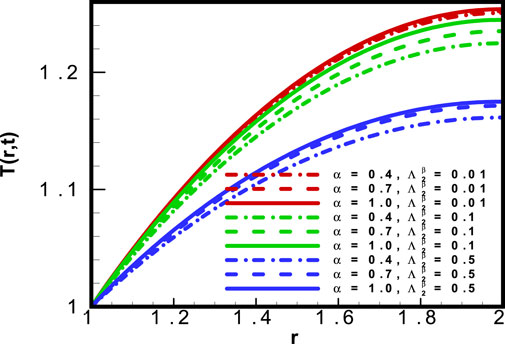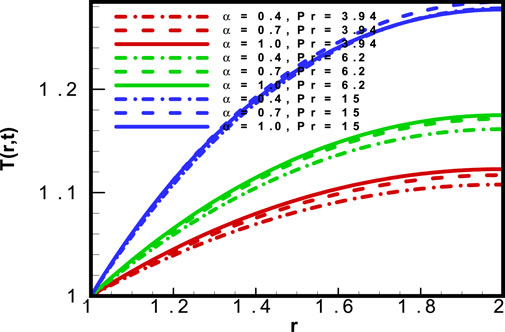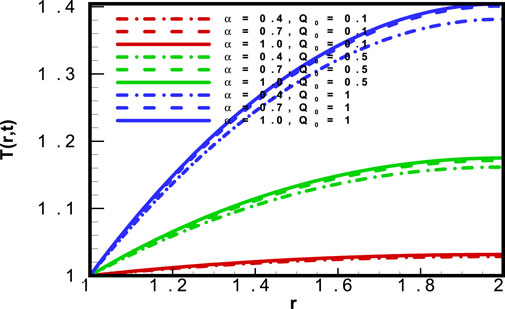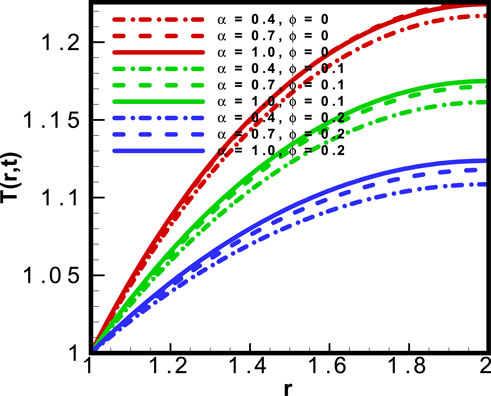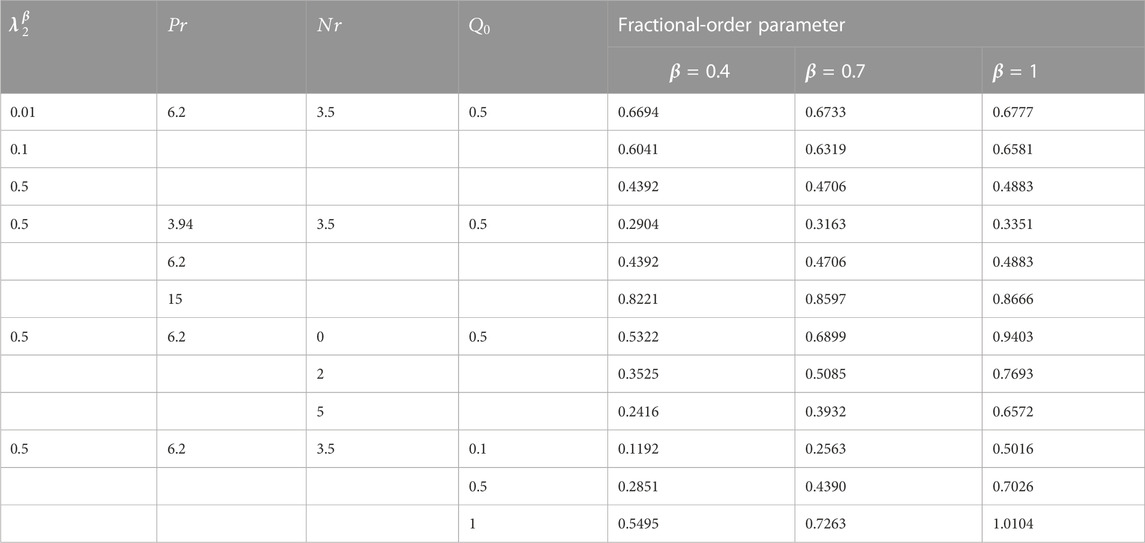- 1Department of Mathematics, School of Sciences, University of Management and Technology, Lahore, Pakistan
- 2School of Mathematical Science, Jiangsu University, Zhenjiang, China
- 3Department of Mathematics, National University of Modern Languages (NUML), Islamabad, Pakistan
- 4Department of Mathematics, Faculty of Science, Umm Al-Qura University, Makkah, Saudi Arabia
- 5Faculty of Engineering and Technology, Future University in Egypt, New Cairo, Egypt
This study deals with numerical solution of momentum and heat transfer of fractional ordered Maxwell fluids within a coaxial cylinder. It is well known that the complex dynamics of flow regime can be well-described by the fractional approach. In this paper, a fractional differentiation operator
Introduction
The viscoelastic flow of Maxwell fluids within a circular cylinder requires more attention in many areas, such as the chemical, food, and petroleum industries. Nguyen et al. (1983), Nieckele and Patankar (1985), Hayase et al. (1992), Haldar (1998), and Chung (1999) have studied viscoelastic flow between two concentric cylinders. Dependent flow of second-grade fluid in cylindrical geometry has been investigated by Ting (1963). In a similar trend, Maxwell fluids have been examined in a cylindrical coordinate system (Srivastava, 1966). Also, Waters and King (1971) studied Oldroyd-B fluid focused in a cylindrical domain. All results were analytically driven. Considerable work has been carried out by Fetecau et al. in investigating one-dimensional viscoelastic flow between circular regions under different conditions, such as a rotating axis. In Fetecau et al. (2008), an exact solution of Oldroyd-B fluid was examined. A solution was offered as the sum of steady-state and transient-state solution. M Jamil et al., studied helical flow Maxwell fluids by using the analytical approach of Hankel transformation (Jamil and Fetecau, 2010). Wood investigated an exact solution of Oldroyd-B fluids in a straight pipe of circular cross sections (Wood, 2001). However, the study of coaxial cylindrical geometry of an oscillating inner cylinder has been infrequent. An important geometry and motion problem is that of cylindrical geometry. Finite or infinite lengths of annular geometry play vital roles in fluid dynamics. Cylindrical flow has various applications in different fields of the food industry, medicine, chemistry, bio-engineering, and oil exploitation (Hartnett and Kostic, 1989).
In research already discussed, a classical approach of constitutive relations for Maxwell fluids had been applied for mathematical modeling. Recently, the fractional approach of constitutive equations of viscoelastic fluid has been the focus of researchers as the fractional approach can provide a better interpretation of viscoelastic fluids than the classical integer-order derivative approach (Bagley and Torvik, 1983; Friedrich, 1991; Haitao and Mingyu, 2009; Magin, 2010; Ming et al., 2016; Sun et al., 2018).
Fractional calculus has been a hot topic among researchers in the recent era of basic science as it provides a new direction in describing dynamics such as time relaxation, time retardation, viscoelastic behavior, and flow regime. Fractional-order (non-integer) partial differential equations (PDEs) are well-suited to address the physical phenomena related to transportation of heat and mass as well. The fractional mathematical model was initially one of classical integer order, which has been modified by replacing integer-order with non-integer order (Sheikh et al., 2017; Saqib et al., 2018; Saqib et al., 2020). For the purpose fractional differentiation, some operators that have been used include Riemann, Riemann–Liouville, Caputo, Caputo–Fabrizio, and Anatangna Beleanu fractional operators (Shah et al., 2018a; Shah et al., 2018b). Using Laplace and Hankel transformation, the analytical solution of a generalized Maxwell model was solved by Mahmood et al. (2009). Subsequently, exact solutions of fractional Maxwell fluids were investigated using Laplace and Hankel transformation (Fetecau et al., 2010; Fetecau et al., 2011).
For the last few decades, nanotechnology has been a research focus due to its broad range of applications, including those in solar energy, weapons, vehicles, and electronics, stemming from strong thermal properties. Nano-fluids are prepared by mixing up nano-sized (1 nm–100 nm) particles in base fluids (water, blood, engine oil, kerosene oil, etc.). The idea of nano-fluids was first developed by Choi and Eastman (1995), and considerable work has since been by carried out by Tiwari and Das on the effectiveness of different shapes and sizes of nanoparticles in a flow regime (Tiwari and Das, 2007). Using Laplace Transform, a study of a nano-fluid model has been done, while considering the flow passing through an accelerating infinite vertical plate situated in porous medium. Activation energy of Maxwell nano-fluids and binary chemical reaction of carbon nanotubes (CNTs) have been investigated using Runge–Kutta on MAPLE (Subbarayudu et al., 2019). Non-Newtonian nano-fluids have been examined numerically by Rashad et al. (2013) using finite difference methods (FDMs). In Rashad and Nabwey (2019), FDM was applied to investigate the gyrotactic mixed bioconvection flow of a nano-fluid passing through a circular region.
Considering the literature discussed previously, research gaps exist. These include the following:
• Lack of study of the problems involving non-linearity and cylindrical geometry.
• Assumptions made to simplify systems governing equations to obtain analytical solutions.
• Application of analytical techniques to calculate results.
In order to address these gaps, we focused on unsteady flow fractional Maxwell nano-fluids between coaxial cylinders. Flow through an annular region was assumed due to oscillation of the inner cylinder under the effects of thermal radiation and strong magnetic field. Due to its flexibility and efficiency in addressing problems with initial and boundary conditions, the Caputo time fractional operator was used as the mathematical model. Cylindrical geometry is complex to solve numerically, therefore, the numerical approach of the finite difference method was applied to obtain the results. We compared the results obtained using the built-in command in MAPLE with those obtained using our model.
Mathematical formulation
Suppose that an incompressible, unsteady, and one-dimensional flow of viscoelastic nano-fluid is at rest at time
The following assumptions were made for the aforementioned problem.
• The flow is one-dimensional, unsteady, and incompressible.
• Body forces are considered.
• Viscous dissipation and pressure gradients are neglected.
• Fluid is magnetic-hydro-dynamic (MHD), but induced magnetic field is ignored.
• Thermal radiation is applied.
Then, the equation of continuity in cylindrical form (Zhang et al., 2019) is as follows:
The stress tensor for fractional Maxwell nano-fluid (Anwar et al., 2020) is as follows:
and
in which
Also,
In the expression,
Accounting for significant body forces and the strong magnetic field (neglecting induced magnetic field) to which the cylinders are subjected, then the Navier Stokes equation in cylindrical form (Zhao et al., 2022) is as follows:
With rotational symmetry
In the aforementioned expression,
Also,
Taking into the account that
Multiplying both sides of the aforementioned equation by
In this expression,
In Askey and Roy (2010),
By following a similar trend for heat transfer analysis, the governing equation for temperature profile is expressed as (Khan and Mustafa, 2018)
In the aforementioned expression,
where
Using Taylor series expansion, approximation of
Eq. 17 takes the following form;
Then, multiplying both sides of Eq. 15 by
Using Eq. 18, the resulting expression is as follows:
The proposed initial and boundary conditions for momentum and heat of this physical phenomenon are given as follows:
For temperature,
Under the aforementioned initial and boundary conditions,
Introducing the transformation for proposed geometry in Eqs 14, 20,
and with the usage of thermo-physical properties of nanoparticles,
The non-dimensional form of velocity profile along a circular cylinder is as follows:
The heat equation takes the following dimensionless form:
The dimensionless initial and boundary conditions are as follows:
For temperature profile,
The dimensionless velocity and temperature profiles of the problem are given, and after eliminating
and
Also, initial and boundary conditions are as follows:
For temperature profile,
where
The dimensionless governing equations for velocity and temperature profiles in Eqs 32, 33 and non-dimensional initial and boundary conditions in Eqs 34–37 express the physical phenomenon of flow of fractional Maxwell nano-fluid within a coaxial cylinder under the influence of magnetic field and heat source/sink, in which

TABLE 1. Contains the numerical values of nanoparticles and different base fluids at room temperature 25° presented in (Usman et al., 2018).
Skin friction and Nusselt number
The significant physical quantities of skin friction and local Nusselt number for prescribed geometry are described as follows (Khan and Mustafa, 2018):
The instantaneous Nusselt number near the wall for a cylindrical region is given as follows (Zhao et al., 2022):
After applying the fractional Maxwell operator to both sides of Eqs 38, 39, we have
and
Using transformations and the thermo-physical properties of nano-fluids expressed in Eq. 25,
The dimensionless expression for the Nusselt number is obtained (after ignoring the star notation) as follows:
in which
Numerical procedure
The numerical technique of the finite difference method is a strong and accurate tool used for solving the partial difference equation, even of non-linear order. The proposed model is a non-linear coupled model of PDEs that express the momentum and temperature equations. The discretization of governing equations are expressed as. It is well-known that the discretization of
In Eq. 44,
For
Results and discussion
We have developed a fractional model of Maxwell nano-fluids under the effects of magnetic field, thermal radiation, and heat source/sink. The physical properties of nano-fluids were utilized to model the physical phenomenon. The focus of the problem was the cylindrical coordinate system in which coaxial geometry was assumed to formulate the problem. Using the Caputo fractional order operator in the model, the finite difference scheme was applied to obtain numerical results using mathematical software MAPLE. In this section, we report our results and discuss the plots and comparison, of important physical properties such as
The results were obtained through discretization of the governing equations (Eqs 32, 33), with initial and boundary conditions expressed in Eqs 34–37. The graphical results for the velocity profile
Figure 2 shows the results obtained for velocity profile
In Figure 3, the results for velocity profile
The plot for velocity
Figure 5 depicts the results for the most important physical parameter: the volumetric fraction
Figure 6 is a graphical representation of the maximum velocity term
The term
The impact of the time relaxation parameter
The impact of the Prandlt number (
In Figure 10, the temperature profile
Figure 11 describes the conduct of the heat profile
The addition of nanoparticles to base fluids enhances entropy generation, and there is reduced loss of useful energy. This expected result was obtained over a range of values of volumetric fraction of nanoparticles
The important physical quantities of skin friction(
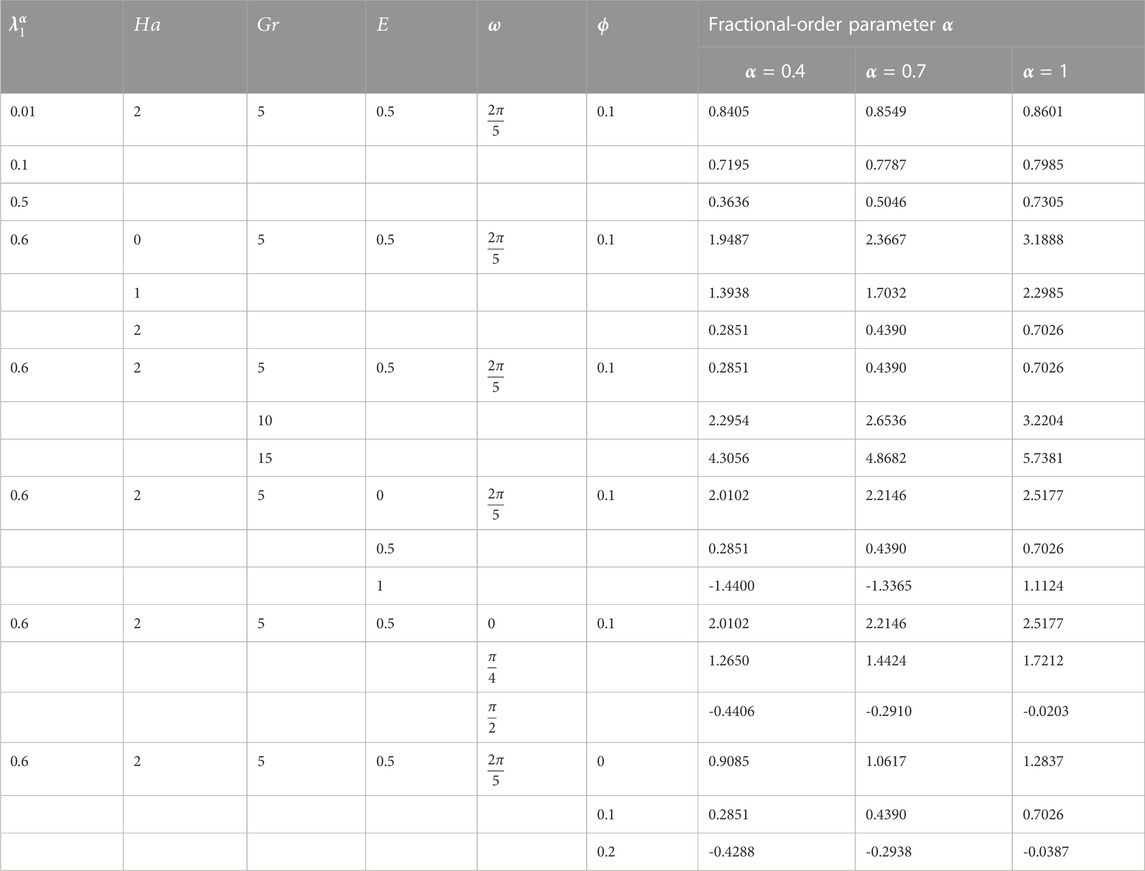
TABLE 2. Variation in the skin friction coefficient with respect to varying physical parameters and
Table 2 shows an ascending trend in
Similar behavior of
Validation of scheme
This section of the study focused on validation of the proposed scheme. The graphical results were obtained by using mathematical software MAPLE. Figures 13A, B depict the effectiveness and accuracy of the proposed scheme for the velocity profile
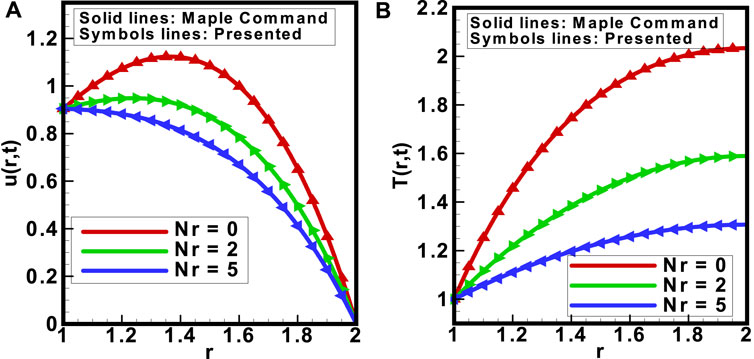
FIGURE 13. Comparison between the MAPLE built-in command results and results obtained from the model for (A) velocity and (B) temperature profiles in respect to the variation in
Figures 14A, B illustrate the comparison between results obtained using the built-in command in MAPLE and results obtained using the proposed scheme. The investigation assessed the velocity profile
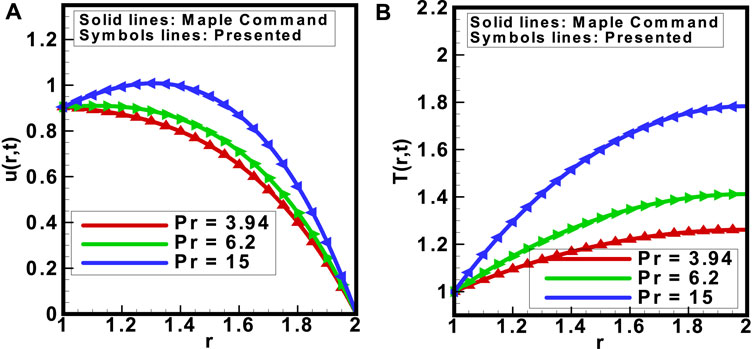
FIGURE 14. Comparison between the MAPLE built-in command results and results obtained from the model for (A) velocity and (B) temperature profiles in respect to the variation in
Conclusion
In this study, we numerically investigated the MHD flow of fractional Maxwell nano-fluid and heat transfer. The flow was measured within a cylindrical coordinate system in which coaxial geometry was considered. Thermal radiation was applied across the circular region. Water (
• By increasing the angular frequency of inner cylinder velocity, the velocity profile of fractional Maxwell nano-fluids is increased.
• The addition of
• Subjecting the system to a strong magnetic field increases heat transfer and lowers the velocity profile of the system.
• The thermal radiation parameter
• The non-dimensional parameters
• The finite difference scheme is a strong technique that can be used to solve fractional-order mathematical models.
• The result validation section shows that the scheme applied is strong and effective for the proposed problem in cylindrical geometry.
• These findings lead further toward the numerical investigation of fractional Maxwell bio-nano fluids within blood arteries.
Data availability statement
The original contributions presented in the study are included in the article/Supplementary material; further inquiries can be directed to the corresponding author.
Author contributions
Conceptualization, MIA; methodology, MU; validation, ATA; investigation, MIA; writ draft preparation, AA and MU; write and editing, TEM; visualization, MU and AA; supervision, MIA; project administration, ATA; funding acquisition, TEM. All authors have read and agreed to the published version of the manuscript.
Acknowledgments
The authors are grateful to HEC Pakistan for facilitating this research underresearch project No 15911 (NRPU).
Conflict of interest
The authors declare that the research was conducted in the absence of any commercial or financial relationships that could be construed as a potential conflict of interest.
Publisher’s note
All claims expressed in this article are solely those of the authors and do not necessarily represent those of their affiliated organizations, or those of the publisher, the editors, and the reviewers. Any product that may be evaluated in this article, or claim that may be made by its manufacturer, is not guaranteed or endorsed by the publisher.
References
Aleem, M., Asjad, M. I., Shaheen, A., and Khan, I. (2020). MHD Influence on different water based nanofluids (TiO2, Al2O3, CuO) in porous medium with chemical reaction and Newtonian heating. Chaos, Solit. Fractals 130, 109437. doi:10.1016/j.chaos.2019.109437
Anwar, T., Kumam, P., Khan, I., and Watthayu, W. (2020). Heat transfer enhancement in unsteady MHD natural convective flow of CNTs Oldroyd-B nanofluid under ramped wall velocity and ramped wall temperature. Entropy 22 (4), 401. doi:10.3390/e22040401
Asjad, M. I., Shah, N. A., Aleem, M., and Khan, I. (2017). Heat transfer analysis of fractional second-grade fluid subject to Newtonian heating with caputo and caputo-fabrizio fractional derivatives: A comparison. Eur. Phys. J. plus 132 (8), 340–358. doi:10.1140/epjp/i2017-11606-6
Askey, R. A., and Roy, R., Gamma function. Available at: https://en.wikipedia.org/wiki/Gamma_function, 2010.
Awan, A. U., Imran, M., Athar, M., Kamran, M., et al. (2020). Exact analytical solutions for a longitudinal flow of a fractional Maxwell fluid between two coaxial cylinders. Punjab Univ. J. Math. 45 (1).
Bagley, R. L., and Torvik, P. (1983). A theoretical basis for the application of fractional calculus to viscoelasticity. J. Rheology 27 (3), 201–210. doi:10.1122/1.549724
Choi, S. U., and Eastman, J. A. (1995). “Enhancing thermal conductivity of fluids with nanoparticles,” in Conference: 1995 International mechanical engineering congress and exhibition, Argonne, IL (United States) (Lemont, IL: Argonne National Lab.ANL).
Chung, J. (1999). Numerical investigation on the bifurcative natural convection in a horizontal concentric annulus. Numer. Heat. Transf. Part A Appl. 36 (3), 291–307. doi:10.1080/104077899274778
Fetecau, C., Hayat, T., and Fetecau, C. (2008). Starting solutions for oscillating motions of Oldroyd-B fluids in cylindrical domains. J. Newt. fluid Mech. 153 (2-3), 191–201. doi:10.1016/j.jnnfm.2008.02.005
Fetecau, C., Mahmood, A., and Jamil, M. (2010). Exact solutions for the flow of a viscoelastic fluid induced by a circular cylinder subject to a time dependent shear stress. Commun. Nonlinear Sci. Numer. Simul. 15 (12), 3931–3938. doi:10.1016/j.cnsns.2010.01.012
Fetecau, C., Retracted, A. R. T. I. C. L. E., Jamil, M., and Mahmood, A. (2011). Retracted article: Flow of fractional Maxwell fluid between coaxial cylinders. Archive Appl. Mech. 81 (8), 1153–1163. doi:10.1007/s00419-011-0536-x
Friedrich, C. (1991). Relaxation and retardation functions of the Maxwell model with fractional derivatives. Rheol. Acta 30 (2), 151–158. doi:10.1007/bf01134604
Haitao, Q., and Mingyu, X. (2009). Some unsteady unidirectional flows of a generalized Oldroyd-B fluid with fractional derivative. Appl. Math. Model. 33 (11), 4184–4191. doi:10.1016/j.apm.2009.03.002
Haldar, S. (1998). Combined convection in developing flow through a horizontal concentric annulus. Numer. Heat. Transf. Part A Appl. 34 (6), 673–685. doi:10.1080/10407789808914009
Hartnett, J. P., and Kostic, M. (1989). Heat transfer to Newtonian and non-Newtonian fluids in rectangular ducts. Adv. heat Transf. 19, 247–356. Elsevier. doi:10.1016/S0065-2717(08)70214-4
Hayase, T., Humphrey, J., and Greif, R. (1992). Numerical calculation of convective heat transfer between rotating coaxial cylinders with periodically embedded cavities. J. Heat. Transf. 114 (3), 589–597. doi:10.1115/1.2911322
Jamil, M., and Fetecau, C. (2010). Helical flows of Maxwell fluid between coaxial cylinders with given shear stresses on the boundary. Nonlinear Anal. Real World Appl. 11 (5), 4302–4311. doi:10.1016/j.nonrwa.2010.05.016
Khan, J. A., and Mustafa, M. (2018). A numerical analysis for non-linear radiation in MHD flow around a cylindrical surface with chemically reactive species. Results Phys. 8, 963–970. doi:10.1016/j.rinp.2017.12.067
Liu, F., Anh, V., and Turner, I. (2004). Numerical solution of the space fractional Fokker–Planck equation. J. Comput. Appl. Math. 166 (1), 209–219. doi:10.1016/j.cam.2003.09.028
Magin, R. L. (2010). Fractional calculus models of complex dynamics in biological tissues. Comput. Math. Appl. 59 (5), 1586–1593. doi:10.1016/j.camwa.2009.08.039
Mahmood, A., Parveen, S., Ara, A., and Khan, N. (2009). Exact analytic solutions for the unsteady flow of a non-Newtonian fluid between two cylinders with fractional derivative model. Commun. Nonlinear Sci. Numer. Simul. 14 (8), 3309–3319. doi:10.1016/j.cnsns.2009.01.017
Ming, C., Liu, F., Zheng, L., Turner, I., and Anh, V. (2016). Analytical solutions of multi-term time fractional differential equations and application to unsteady flows of generalized viscoelastic fluid. Comput. Math. Appl. 72 (9), 2084–2097. doi:10.1016/j.camwa.2016.08.012
Nguyen, T. H., Vasseur, P., Robillard, L., and Chandra Shekar, B. (1983). Combined free and forced convection of water between horizontal concentric cylinders. J. Heat. Transf. 105 (3), 498–504. doi:10.1115/1.3245613
Nieckele, A., and Patankar, S. (1985). Laminar mixed convection in a concentric annulus with horizontal axis. J. Heat. Transf. 107 (4), 902–909. doi:10.1115/1.3247519
Rashad, A., Chamkha, A. J., and Abdou, M. (2013). Mixed convection flow of non-Newtonian fluid from vertical surface saturated in a porous medium filled with a nanofluid. J. Appl. Fluid Mech. 6 (2), 301–309.
Rashad, A., and Nabwey, H. A. (2019). Gyrotactic mixed bioconvection flow of a nanofluid past a circular cylinder with convective boundary condition. J. Taiwan Inst. Chem. Eng. 99, 9–17. doi:10.1016/j.jtice.2019.02.035
Rosseland, S. (2013). Astrophysik: Auf atomtheoretischer grundlage, 11. Berlin, Germany: Springer-Verlag.
Salah, F., (2013). MHD accelerated flow of Maxwell fluid in a porous medium and rotating frame. Int. Sch. Res. Notices.
Saqib, M., Ali, F., Khan, I., Sheikh, N. A., Jan, S. A. A., and Samiulhaq, (2018). Exact solutions for free convection flow of generalized jeffrey fluid: A caputo-fabrizio fractional model. Alexandria Eng. J. 57 (3), 1849–1858. doi:10.1016/j.aej.2017.03.017
Saqib, M., Hanif, H., Abdeljawad, T., Khan, I., Shafie, S., and Sooppy Nisar, K. (2020). Heat transfer in mhd flow of Maxwell fluid via fractional cattaneo-friedrich model: A finite difference approach. Comput. Mat. Contin. 65 (3), 1959–1973. doi:10.32604/cmc.2020.011339
Shah, N. A., Elnaqeeb, T., Animasaun, I. L., and Mahsud, Y. (2018). Insight into the natural convection flow through a vertical cylinder using caputo time-fractional derivatives. Int. J. Appl. Comput. Math. 4 (3), 80–18. doi:10.1007/s40819-018-0512-z
Shah, N., Hajizadeh, A., Zeb, M., Ahmad, S., and Mahsud, Y. (2018). Effect of magnetic field on double convection flow of viscous fluid over a moving vertical plate with constant temperature and general concentration by using new trend of fractional derivative. Open J. Math. Sci. 2 (1), 253–265. doi:10.30538/oms2018.0033
Sheikh, N. A., Ali, F., Saqib, M., Khan, I., Jan, S. A. A., Alshomrani, A. S., et al. (2017). Comparison and analysis of the Atangana–Baleanu and Caputo–Fabrizio fractional derivatives for generalized Casson fluid model with heat generation and chemical reaction. Results Phys. 7, 789–800. doi:10.1016/j.rinp.2017.01.025
Srivastava, P. (1966). Non-steady helical flow of a visco-elastic liquid(Nonsteady helical flow of viscoelastic liquid contained in circular cylinder, noting occurrence of oscillations in fluid decaying exponentially with time). Arch. Mech. Stosow. 18 (2), 145–150.
Subbarayudu, K., Suneetha, S., Bala Anki Reddy, P., and Rashad, A. M. (2019). Framing the activation energy and binary chemical reaction on CNT’s with Cattaneo–Christov heat diffusion on Maxwell nanofluid in the presence of nonlinear thermal radiation. Arabian J. Sci. Eng. 44 (12), 10313–10325. doi:10.1007/s13369-019-04173-2
Sun, H., Zhang, Y., Wei, S., Zhu, J., and Chen, W. (2018). A space fractional constitutive equation model for non-Newtonian fluid flow. Commun. Nonlinear Sci. Numer. Simul. 62, 409–417. doi:10.1016/j.cnsns.2018.02.007
Taitel, Y., and Hartnett, J. (1968). Application of Rosseland approximation and solution based on series expansion of the emission power to radiation problems. AIAA J. 6 (1), 80–89. doi:10.2514/3.4444
Ting, T. W. (1963). Certain non-steady flows of second-order fluids. Archive Ration. Mech. Analysis 14 (1), 1–26. doi:10.1007/bf00250690
Tiwari, R. K., and Das, M. K. (2007). Heat transfer augmentation in a two-sided lid-driven differentially heated square cavity utilizing nanofluids. Int. J. heat Mass Transf. 50 (9-10), 2002–2018. doi:10.1016/j.ijheatmasstransfer.2006.09.034
Usman, M., Hamid, M., Zubair, T., Ul Haq, R., and Wang, W. (2018). Cu-AlO/Water hybrid nanofluid through a permeable surface in the presence of nonlinear radiation and variable thermal conductivity via LSM. Int. J. Heat Mass Transf. 126, 1347–1356. doi:10.1016/j.ijheatmasstransfer.2018.06.005
Waters, N., and King, M. (1971). The unsteady flow of an elastico-viscous liquid in a straight pipe of circular cross section. J. Phys. D Appl. Phys. 4 (2), 304–211. doi:10.1088/0022-3727/4/2/304
Wood, W. (2001). Transient viscoelastic helical flows in pipes of circular and annular cross-section. J. Newt. fluid Mech. 100 (1-3), 115–126. doi:10.1016/s0377-0257(01)00130-6
Zhang, Y., Jiang, J., and Bai, Y. (2019). MHD flow and heat transfer analysis of fractional Oldroyd-B nanofluid between two coaxial cylinders. Comput. Math. Appl. 78 (10), 3408–3421. doi:10.1016/j.camwa.2019.05.013
Zhao, Q., Mao, B., Bai, X., Chen, C., and Wang, Z. (2022). Heat transfer suppression mechanism of magnetogasdynamic flow in a circular tube subjected to transverse magnetic field regulation. Int. Commun. Heat Mass Transf. 134, 105990. doi:10.1016/j.icheatmasstransfer.2022.105990
Nomenclature
velocity
temperature
density of nano-fluid
dynamic viscosity of nano-fluid
thermal conductivity of nano-fluid
volumetric thermal expansion coefficient
gravitational acceleration
heat capacity of nanoparticles
electrical conductivity of nanoparticles
kinematic viscosity of nanoparticles
volume fraction of nanoparticles
radius of the inner cylinder
radius of the outer cylinder
Keywords: fractional calculus, Maxwell fluids, cylindrical coordinate, nano-fluids, thermal radiations
Citation: Asjad MI, Usman M, Assiri TA, Ali A and Tag-ElDin EM (2023) Numerical investigation of fractional Maxwell nano-fluids between two coaxial cylinders via the finite difference approach. Front. Mater. 9:1050767. doi: 10.3389/fmats.2022.1050767
Received: 22 September 2022; Accepted: 21 December 2022;
Published: 10 January 2023.
Edited by:
Safia Akram, National University of Sciences and Technology, PakistanReviewed by:
A. M. Rashad, Aswan University, EgyptNdolane Sene, Cheikh Anta Diop University, Senegal
Copyright © 2023 Asjad, Usman, Assiri, Ali and Tag-ElDin. This is an open-access article distributed under the terms of the Creative Commons Attribution License (CC BY). The use, distribution or reproduction in other forums is permitted, provided the original author(s) and the copyright owner(s) are credited and that the original publication in this journal is cited, in accordance with accepted academic practice. No use, distribution or reproduction is permitted which does not comply with these terms.
*Correspondence: Muhammad Imran Asjad, SW1yYW4uYXNqYWRAdW10LmVkdS5waw==
†These authors have contributed equally to this work
 Muhammad Imran Asjad
Muhammad Imran Asjad Muhammad Usman
Muhammad Usman Taghreed A. Assiri4†
Taghreed A. Assiri4† Arfan Ali
Arfan Ali ElSayed M. Tag-ElDin
ElSayed M. Tag-ElDin